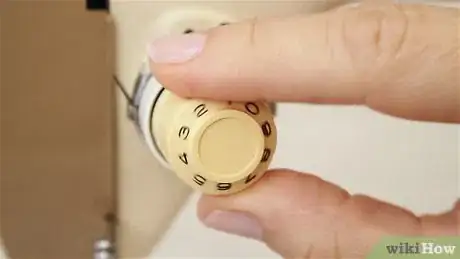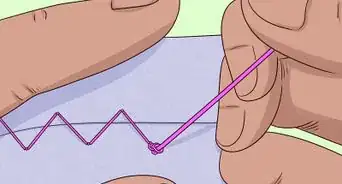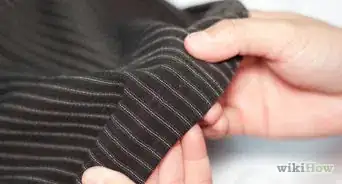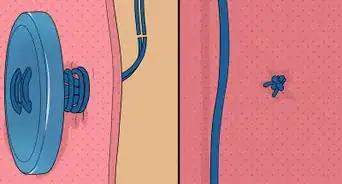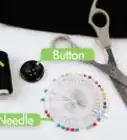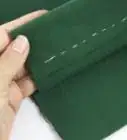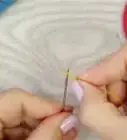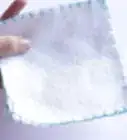This article was co-authored by Kpoene Kofi-Bruce. Kpoene Kofi-Bruce is a tailor, couture wedding gown designer, and the Creative Director of Mignonette Bridal and Ette the Wedding Tailor in Chicago, Illinois. With nearly two decades of experience as a wedding gown designer, small business owner, and vintage sewing enthusiast, Kpoene specializes in wedding gown design and the social history of wedding dresses. She received a BA in Creative Writing from Middlebury College and studied the business of fashion at the Fashion Institute of Technology. She is also a graduate of the Goldman Sachs 10KSB program and the Chicago Fashion Incubator and has written about wedding fashion for Jezebel, Catalyst, the Sun Times, and XO Jane.
wikiHow marks an article as reader-approved once it receives enough positive feedback. In this case, 100% of readers who voted found the article helpful, earning it our reader-approved status.
This article has been viewed 219,716 times.
A French seam is actually a method for making a double seam that is used to hide the rough edges of fabric. French seaming is most often used when making articles of clothing, but it also works well on a variety of other sewing projects. It is a technique that makes the seams of your handmade garment strong, neat, and professional looking, even replacing the need for a serger in some cases. Follow a few simple directions and you will be able to easily sew a French seam on your own.
Steps
Sewing the First Seam
-
1Set up your sewing machine. Use a straight stitch, not a zigzag stitch. Consider the stitch size setting and thread tension you will need for sewing your particular fabric. If you are unsure, consult the directions for your sewing machine and adjust settings accordingly. Also prepare your sewing machine by threading it with a thread that matches the color and strength of the material you are going to sew.
- This is also a good time to plug in your iron, so that it's already heated up when you need it.
-
2Pin your fabric together so that the wrong sides are facing each other. Putting the wrong sides together is the opposite of what is normally done when sewing a basic seam, so don't worry if it feels counterintuitive.[1] A French seam requires you to stitch each seam twice, folding over your first line of stitches in order to make your finished seam face the right direction.
- Be sure to pin all the way down the seam you are sewing. This will help to make sure your fabric doesn't slip out of line.
- It's a good idea to put pins in so they are perpendicular to your seam line, this way they won't stick you as you move the fabric along in the sewing machine and they will be easy to grab as you move your fabric in the sewing machine.
Advertisement -
3Sew the fabric together using a 1/4 inch seam allowance, removing pins as you go. To keep your seam allowance the same width as you sew your seam, keep an eye on the seam allowance guide that should be printed on the thread plate of your machine. Another option is to use a 1/4 inch presser foot, that way you can just make sure the outer edge of your fabric always lines up with the edge of the presser foot[2] .
- The seam allowance is the amount of fabric that is between the edge of the fabric and the seam. Patterns usually give a specific amount of seam allowance to use, so that your finished project doesn't turn out too bit or too small. [3] Remember that the french seam will basically require about double the allowance you use on this first seam, so make sure when you are cutting out your pieces of fabric that you have figured that into your measurements.
- Feel free to increase the seam allowance on this first seam to 3/8 inch, if you are more comfortable sewing that width, but keep in mind that you will need to increase your overall seam allowance to accommodate this.
- It's best to remove pins right before you are about to sew over them. This will keep the fabric in place but will avoid the risk of hitting one with your sewing machine needle, which could easily break the needle.
- Remember to clip any threads and remove any remaining pins after sewing.
-
4Trim the outside edge of the seam so you are left with 1/8 inch seam allowance. You can use regular scissors or pinking shears, but if you are using a delicate fabric, pinking shears may be best to help prevent excessive fraying. Remember, this seam is not going to show by the time you are finished. Don't worry if the cut edge is a bit frayed or messy.
- Be sure to use very sharp scissors for this.[4]
- While it would be great if you could just sew a 1/8 inch seam, and therefore not waste any fabric, most sewing machines need more than 1/8 inch of fabric for the machine's feed dogs, the pieces of rough metal under the presser foot, to grab onto and pull along.
-
5Iron your first seam. Open the pieces of fabric and lay it out flat on an ironing board. Iron across the seam on both the right side and the wrong side of the fabric so it lays perfectly flat. Then fold the fabric so that the right sides are facing each other (the opposite of how it was when you sewed the first seam). Iron the piece with the seam you just sewed going straight down the outer edge of the fabric. You'll want to iron very carefully and neatly so that the seam on the outer edge is perfectly straight.[5]
- Make sure your iron is set to the correct temperature for the fabric you are using. If it is set to high you will risk singeing the fabric.
Sewing the Second Seam
-
1Pin your fabric so that the wrong sides of your fabric are facing out. This should be easy, as you have just ironed them into place. Again, put your pins in horizontally all the way down the side of the seam so that they can be easily removed while you are sewing. The frayed edge should now be concealed between the two pieces of fabric and the outer edge is just the neat row of your first set of stitches.
-
2Sew your second seam, this time using a 3/8 inch seam allowance. You need this amount of allowance so that the frayed edge of the fabric is tucked away neatly between the two seams. As you sew, remove the pins. Once again, remember to clip threads and remove any stray pins after sewing the seam.[6]
- If your seam allowance is too small on the second seam, the rough edges of the fabric could end up sticking out of the second seam on the finished side of your project. Its better to be cautious and make your seam allowance a bit generous.
-
3Iron the completed double seam one more time. Press the seam to one side, depending on where you would like it to lay in your finished project. Your raw edges are no longer exposed as they are enclosed inside your newly made French seam.[7]
Expert Q&A
-
QuestionWhat materials do I need for this?
 Kpoene Kofi-BruceKpoene Kofi-Bruce is a tailor, couture wedding gown designer, and the Creative Director of Mignonette Bridal and Ette the Wedding Tailor in Chicago, Illinois. With nearly two decades of experience as a wedding gown designer, small business owner, and vintage sewing enthusiast, Kpoene specializes in wedding gown design and the social history of wedding dresses. She received a BA in Creative Writing from Middlebury College and studied the business of fashion at the Fashion Institute of Technology. She is also a graduate of the Goldman Sachs 10KSB program and the Chicago Fashion Incubator and has written about wedding fashion for Jezebel, Catalyst, the Sun Times, and XO Jane.
Kpoene Kofi-BruceKpoene Kofi-Bruce is a tailor, couture wedding gown designer, and the Creative Director of Mignonette Bridal and Ette the Wedding Tailor in Chicago, Illinois. With nearly two decades of experience as a wedding gown designer, small business owner, and vintage sewing enthusiast, Kpoene specializes in wedding gown design and the social history of wedding dresses. She received a BA in Creative Writing from Middlebury College and studied the business of fashion at the Fashion Institute of Technology. She is also a graduate of the Goldman Sachs 10KSB program and the Chicago Fashion Incubator and has written about wedding fashion for Jezebel, Catalyst, the Sun Times, and XO Jane.
Couture Bridal Designer You'll need an iron, a pair of small, very sharp scissors, a cutting surface, and a sewing machine.
You'll need an iron, a pair of small, very sharp scissors, a cutting surface, and a sewing machine. -
QuestionHow do you line up the fabric in a French seam?
 Kpoene Kofi-BruceKpoene Kofi-Bruce is a tailor, couture wedding gown designer, and the Creative Director of Mignonette Bridal and Ette the Wedding Tailor in Chicago, Illinois. With nearly two decades of experience as a wedding gown designer, small business owner, and vintage sewing enthusiast, Kpoene specializes in wedding gown design and the social history of wedding dresses. She received a BA in Creative Writing from Middlebury College and studied the business of fashion at the Fashion Institute of Technology. She is also a graduate of the Goldman Sachs 10KSB program and the Chicago Fashion Incubator and has written about wedding fashion for Jezebel, Catalyst, the Sun Times, and XO Jane.
Kpoene Kofi-BruceKpoene Kofi-Bruce is a tailor, couture wedding gown designer, and the Creative Director of Mignonette Bridal and Ette the Wedding Tailor in Chicago, Illinois. With nearly two decades of experience as a wedding gown designer, small business owner, and vintage sewing enthusiast, Kpoene specializes in wedding gown design and the social history of wedding dresses. She received a BA in Creative Writing from Middlebury College and studied the business of fashion at the Fashion Institute of Technology. She is also a graduate of the Goldman Sachs 10KSB program and the Chicago Fashion Incubator and has written about wedding fashion for Jezebel, Catalyst, the Sun Times, and XO Jane.
Couture Bridal Designer Start by placing your fabric so the wrong sides are facing each other—you'll sew the first seam on the outside of the garment. Then, trim away the seam allowance, leaving about 1/8". Fold your fabric together at the seam so what you just sewed is sandwiched between the fabric and the right sides are together, then press along that seam line. Pin it if you need to, sew along the seam line again, then press the seam one more time and you're finished!
Start by placing your fabric so the wrong sides are facing each other—you'll sew the first seam on the outside of the garment. Then, trim away the seam allowance, leaving about 1/8". Fold your fabric together at the seam so what you just sewed is sandwiched between the fabric and the right sides are together, then press along that seam line. Pin it if you need to, sew along the seam line again, then press the seam one more time and you're finished! -
QuestionWhat stitches should I use?
 Community AnswerSew the seam with a 1/4" seam allowance with the fabric wrong sides together. Flip the fabric to right sides together and sew the seam again with a 3/8" seam allowance, enclosing the raw edges of the first seam.
Community AnswerSew the seam with a 1/4" seam allowance with the fabric wrong sides together. Flip the fabric to right sides together and sew the seam again with a 3/8" seam allowance, enclosing the raw edges of the first seam.
Things You'll Need
- Sewing machine
- Material
- Matching thread
- Iron
- Ironing board
- Pins
- Scissors
References
- ↑ Kpoene Kofi-Bruce. Couture Bridal Designer. Expert Interview. 28 January 2021.
- ↑ Kpoene Kofi-Bruce. Couture Bridal Designer. Expert Interview. 28 January 2021.
- ↑ http://howtosew.com/blog/q/what-seam-allowance
- ↑ Kpoene Kofi-Bruce. Couture Bridal Designer. Expert Interview. 28 January 2021.
- ↑ Kpoene Kofi-Bruce. Couture Bridal Designer. Expert Interview. 28 January 2021.
- ↑ Kpoene Kofi-Bruce. Couture Bridal Designer. Expert Interview. 28 January 2021.
- ↑ Kpoene Kofi-Bruce. Couture Bridal Designer. Expert Interview. 28 January 2021.
About This Article
To sew a French seam, start by pinning the fabric with the wrong sides facing each other and sewing it together using a 1/4 inch seam allowance. Next, trim the outside edge of the seam to about 1/8 inch. Open the fabric so that it lays flat, then fold it over so that the right sides of the fabric are facing each other. After folding it on the seam, iron it so that it’s perfectly straight. Finally, sew the edge again, using a 3/8 inch seam allowance this time. For tips on how to modify an existing pattern to use French seams, read on!
